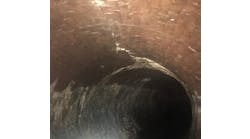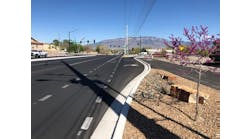As the population in Southern California increases, more and more demands are being put on the state’s groundwater resources, further exacerbating the overdraft problem. Many communities in Southern California are recharging their aquifers with imported surface waters to combat this problem. The major recharge normally is carried out during wet weather periods when surface water is plentiful. However, recharging these groundwater aquifers with imported surface water can create the potential for water quality degradation. The problem can start when surface water is disinfected with chlorine to prevent biofouling and remove pathogens.
Since surface waters contain many organics such as algae, plant tissues and animal tissues, trihalomethanes (THMs) are formed when these waters are chlorinated. THMs are produced due to the chemical interaction of chlorine and organic substances naturally present in surface waters (e.g., humic and fulic acids produced from decaying vegetation). Since these THMs are known carcinogens, it is important to learn about their fate in the aquifer after their introduction through surface water recharge.
THMs belong to a group of organohalogen derivatives of methane (CH4). This happens when three atoms of chlorine, bromine or iodine have replaced three of the four hydrogen atoms. The group includes chloroform (trichloromethane), bromodichloromethane, dibromochloromethane, bromoform (tribromomethane) and dichloroiodomethane. All five of these THMs have been found at detectable concentrations in drinking waters. Chloroform is the THM member most commonly found in drinking water and usually is present in the highest concentration.
The chemical interaction that forms trihalomethanes can continue for an extended period of time. Thus, their concentration can increase over time. The current drinking water standard for THMs is 100 parts per billion (ppb). This level was based on its carcinogenicity in laboratory animals. This standard considers both the risk to a lifetime of exposure and the status of current technology to meet the standard without unreasonable cost.
Project Description
Groundwaters in the Lancaster subbasin, Antelope Valley, Calif., had suffered severe level drops. In order to restore and recharge some of these aquifers, an aquifer storage and recovery (ASR) demonstration project began in 1995.
This project injected surface water into groundwater aquifers for storage during periods when surface water is scarce, usually during the summer and fall in California. The injected water is disinfected and generally chlorinated to prevent biofouling and potential introduction of pathogens before being pumped into the aquifer.
Waste Discharge Requirements
The California State Water project was used as the source water for the ASR project. Most of the water originated from the Sacramento-San Joquin River delta and contained elevated concentrations of dissolved organic carbon (DOC).
The local Water Quality Control Board for the Lancaster area was concerned about the potential for groundwater degradation during the project. Proponents of the project proposed to extract 50 percent more water than that was injected, thus assuring that THMs would not be left in the groundwater. The extracted groundwater was to be purveyed for municipal and domestic use.
The Lahontan Regional Water Quality Control Board adopted Waste Discharge Requirements (WDRs) for the project that addressed three crucial areas. First, the WDRs acknowledged the temporary condition of groundwater degradation. Second, the WDRs required monitoring and reporting to determine the magnitude and extent of groundwater degradation during and after the project. Finally, the WDRs required the implementation of a contingency plan should the condition of degradation extend beyond the pumping depression and/or the condition of degradation not be abated at the end of the project.
Since the project had the potential to cause temporary degradation of water quality, the discharge was required to submit an antidegradation analysis for the project. Based on the antidegradation analysis that contained technical, economic and social factors, the Regional Board found that the condition of temporary degradation was acceptable for the project.
Study Findings
The water quality monitoring during the first two Antelope Valley, Lancaster Aquifer Storage and Recovery Project cycles of the demonstration project revealed high concentrations of trihalomethanes (THMs) in the water recovered after recharge. Monitoring of THM concentrations during ASR cycles at a number of sites in the United States has yielded similar results. These studies found that THMs are definitely formed when waters containing dissolved organics are chlorinated. The THMs in the groundwater appear to decrease but some studies reached opposing conclusions.
The Las Vegas Water Department carried out a similar recharge project. This study concluded that the reduced concentrations of THMs in extracted water could not be due to dilution from native groundwater. Therefore, any reduction in THMs concentrations must be due to biodegradation. The monitoring data collected from the ASR project indicate that THMs are fairly persistent in elevated concentration and the recharge of groundwater with chlorinated surface waters posed a potential threat to the local groundwaters.
Data Analysis
The pH of the injected water in the ASR study varied between 6.3 and 6.85. The pH of the native groundwater samples varied from 7.1 to 8.3. The pH of the extracted water (6.00) was significantly lower than the pH of all of the injected water or groundwater.
The reduced pH of the injected water is due to the reaction of chlorine. When added to water, chlorine forms two acids (hydrochloric and hypochlorous). It is these two acids that act as a disinfectant to deactivate microorganisms.
The ASR project was initiated with the premise that all of the surface water recharged would be pumped out, leaving no detectable traces of THMs or other constituents. This goal was not achieved and residual concentrations of THMs remained in the groundwater (although they were very low).
The study also indicated that THMs continue to form in the groundwater after SWP water was injected. It was observed that after the first two monitoring cycles there was a significant rise in the THMs after injection. These subsided as the water was extracted. Prior to the study it was proposed that all water recharged be removed. However, there was continued presence of low levels of THMs in the pumped out water even after all recharge had supposedly been recovered.
During the study, there were no levels of THMs that exceeded the maximum contaminant level of 100 ppb. Initially, there were increases of chloride and TDS constituents in the groundwater. After a number of recharge cycles, chloride and TDS levels stabilized close to the background levels. These initial increases in chloride and TDS constituent levels are probably due to the low pH of the recharged water that dissolved minerals from the soil strata. After many recharge cycles, all dissolvable salts were depleted, resulting in no further releases of TDS and chloride ions.
Recommendation
Although the MCLs for THMs were not exceeded because of the recharge of disinfected SWP water, disinfection of SWP water with chloroamines and other nonchlorine disinfectants such as UV or ozone should be considered. These alternative disinfectants do not form THMs.


